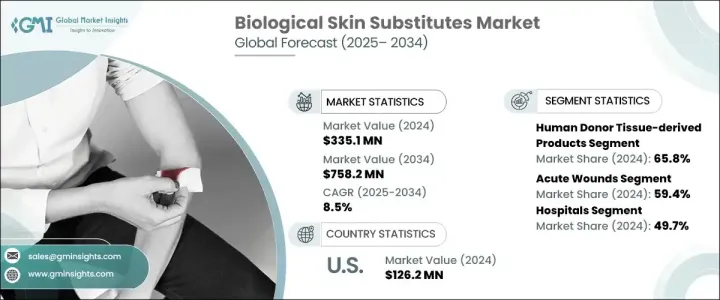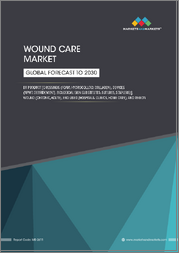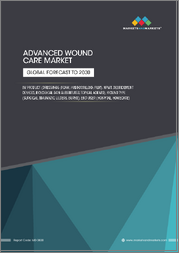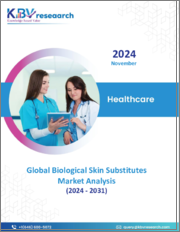
|
시장보고서
상품코드
1699386
생물학적 피부 대체물 시장 기회, 성장 촉진요인, 산업 동향 분석 및 예측(2025-2034년)Biological Skin Substitutes Market Opportunity, Growth Drivers, Industry Trend Analysis, and Forecast 2025-2034 |
||||||
생물학적 피부 대체물 세계 시장은 2024년에 3억 3,510만 달러로 평가되며, 2025-2034년 연평균 8.5%의 성장률을 보일 것으로 예측됩니다.
만성 상처와 화상 증가로 인해 첨단 상처 관리 솔루션, 특히 생물학적 피부 대체재에 대한 수요가 증가하고 있습니다. 이 제품들은 자연 피부를 모방하여 효과적인 조직 통합과 빠른 치유를 보장하기 때문에 전 세계 의료진들이 선호하고 있습니다. 당뇨병, 비만, 노화 관련 질환의 부담이 계속 증가함에 따라 만성 상처의 발생률도 증가하여 시장에 큰 성장 기회를 제공합니다.

첨단 상처 치료에 대한 인식이 높아지고 피부 이식 등 기존 방법의 한계로 인해 생물학적 피부 대체재의 채택이 급증하고 있습니다. 최소침습 수술과 재생의료의 발전으로 이러한 제품의 효능이 더욱 향상되어 현대 의료에 필수적인 요소로 자리 잡고 있습니다. 생명공학 기업들이 연구개발에 많은 투자를 하고 있는 가운데, 업계는 환자들의 치료 결과를 개선하기 위한 혁신적인 솔루션을 속속 내놓고 있습니다. 더 나은 상처 관리를 촉진하기 위한 정부의 이니셔티브와 강력한 신제품 승인 파이프라인은 예측 기간 동안 시장의 모멘텀을 유지할 것으로 예상됩니다.
| 시장 범위 | |
|---|---|
| 시작 연도 | 2024년 |
| 예측 연도 | 2025-2034년 |
| 시작 금액 | 3억 3,510만 달러 |
| 예상 금액 | 7억 5,820만 달러 |
| CAGR | 8.5% |
제품 유형별로는 인간 기증자, 무세포 동물 유래 제품, 조직 유래 제품, 조직 공학 피부, 생합성 피부 대체물 등이 있으며, 2024년에는 인간 기증자 조직 유래 제품이 65.8% 시장 점유율을 차지할 것으로 예상됩니다. 이 제품들은 인간의 피부를 복제하고 자연적 조직 재생을 지원하는 뛰어난 능력으로 인해 널리 선호되고 있습니다. 임상시험과 실제 이용 사례를 통해 중증 및 만성 상처 치료에 효과적이라는 것이 입증되어 의료 전문가들 사이에서 널리 사용되고 있습니다. 이러한 제품의 지속적인 개선과 조직 공학의 발전이 결합되어 시장에서의 우위를 더욱 강화할 수 있게 되었습니다.
응용 분야별로 생물학적 대체 피부는 급성 상처, 만성 상처 및 기타 의료 요구에 사용됩니다. 급성 상처 분야는 2024년 59.4% 시장 점유율을 차지할 것으로 예상되며, 이는 주로 외과적 상처 및 외상 관련 부상의 경우 신속하고 효과적인 치료 옵션에 대한 수요에 기인합니다. 전통적인 피부 이식 방법보다 첨단 생물학적 피부 대체물에 대한 선호도가 높아지면서 이 부문의 성장에 더욱 박차를 가하고 있습니다. 이 제품들은 특히 합병증과 감염을 예방하기 위해 즉각적인 치료가 중요한 응급 상황에서 신속하고 신뢰할 수 있는 치료 솔루션을 제공합니다.
미국의 생물학적 피부 대체재 시장은 2024년 1억 2,620만 달러 규모에 달할 것으로 예상되며, 향후에도 큰 폭의 성장이 예상됩니다. 당뇨병성 족부궤양, 욕창, 화상 등의 발병률이 증가하면서 이러한 첨단 상처 관리 솔루션에 대한 수요가 증가하고 있습니다. 또한, 혁신적인 피부 대체재에 대한 FDA 승인 증가와 함께 주요 생명공학 기업들의 진출로 시장 확대가 가속화되고 있습니다. 세포 기반 및 조직 공학 제품을 포함한 차세대 생체 피부 대체품의 도입은 업계 판도를 재편하고 있습니다. 지속적인 기술 발전과 재생의료에 대한 투자 확대로 미국 시장은 지속적인 성장을 이룰 준비가 되어 있으며, 제조업체와 의료 서비스 제공업체 모두에게 유망한 기회를 제공합니다.
목차
제1장 조사 방법과 조사 범위
제2장 주요 요약
제3장 업계 인사이트
- 생태계 분석
- 업계에 대한 영향요인
- 성장 촉진요인
- 업계의 잠재적 리스크&과제
- 성장 가능성 분석
- 규제 상황
- 향후 시장 동향
- 갭 분석
- 기술 상황
- Porter's Five Forces 분석
- PESTEL 분석
제4장 경쟁 구도
- 서론
- 기업 매트릭스 분석
- 기업 점유율 분석
- 경쟁 포지셔닝 매트릭스
- 벤더 매트릭스 분석
- 전략 대시보드
제5장 시장 추산 및 예측 : 유형별, 2021년-2034년
- 주요 동향
- 인간 기증자 조직 유래 제품
- 무세포 동물 유래 제품
- 조직공학적 피부 제품
- 생합성 피부 제품
제6장 시장 추산 및 예측 : 용도별, 2021년-2034년
- 주요 동향
- 급성 창상
- 만성 창상
- 기타 용도
제7장 용도별 시장 추산·예측 : 최종 용도별, 2021년-2034년
- 주요 동향
- 병원
- 외래수술센터(ASC)
- 전문 클리닉
- 기타 최종 용도
제8장 시장 추산 및 예측 : 지역별, 2021년-2034년
- 주요 동향
- 북미
- 미국
- 캐나다
- 유럽
- 독일
- 프랑스
- 영국
- 이탈리아
- 스페인
- 아시아태평양
- 일본
- 중국
- 인도
- 한국
- 호주
- 라틴아메리카
- 브라질
- 아르헨티나
- 멕시코
- 중동 및 아프리카
- 남아프리카공화국
- 사우디아라비아
- 아랍에미리트(UAE)
제9장 기업 개요
- Aroa Biosurgery
- Avita Medical
- BioTissue
- Integra LifeSciences
- MiMedx Group
- Misonix(Bioventus)
- Organogenesis
- ProgenaCare
- Smith &Nephew
- Stratatech Corporation(Mallinckrodt Pharmaceuticals)
- Stryker
- Tissue Regenix
- Vericel Corporation
The Global Biological Skin Substitutes Market was valued at USD 335.1 million in 2024 and is projected to expand at a CAGR of 8.5% from 2025 to 2034. The increasing prevalence of chronic wounds and burn injuries is driving demand for advanced wound care solutions, particularly biological skin substitutes. These products mimic natural skin, ensuring effective tissue integration and faster healing, making them a preferred choice for healthcare providers worldwide. As the burden of diabetes, obesity, and aging-related conditions continues to rise, so does the incidence of chronic wounds, creating significant growth opportunities for the market.

The increasing awareness regarding advanced wound care treatments and the limitations of conventional methods such as skin grafting have led to a surge in the adoption of biological skin substitutes. Minimally invasive procedures and regenerative medicine advancements have further enhanced the efficacy of these products, making them indispensable in modern healthcare. With biotechnology companies heavily investing in research and development, the industry is witnessing a wave of innovative solutions designed to improve patient outcomes. Government initiatives promoting better wound care management and a strong pipeline of new product approvals are expected to sustain market momentum over the forecast period.
| Market Scope | |
|---|---|
| Start Year | 2024 |
| Forecast Year | 2025-2034 |
| Start Value | $335.1 Million |
| Forecast Value | $758.2 Million |
| CAGR | 8.5% |
The market is categorized based on product type, including human donor acellular animal-derived products, tissue-derived products, tissue-engineered skin, and biosynthetic skin substitutes. In 2024, human donor tissue-derived products accounted for 65.8% of the market share. These products are widely preferred due to their superior ability to replicate human skin and support natural tissue regeneration. Clinical trials and real-world applications have demonstrated their effectiveness in treating severe and chronic wounds, leading to their widespread adoption among healthcare professionals. The continuous refinement of these products, coupled with advancements in tissue engineering, is further reinforcing their market dominance.
Segmentation by application highlights that biological skin substitutes are used for acute wounds, chronic wounds, and other medical needs. The acute wounds segment held a 59.4% market share in 2024, primarily driven by the demand for rapid and effective treatment options in cases of surgical wounds and trauma-related injuries. The growing preference for advanced biological skin substitutes over traditional skin grafting methods is further fueling this segment's expansion. These products provide quick, reliable healing solutions, especially in emergency situations where immediate care is crucial for preventing complications and infections.
The U.S. Biological Skin Substitutes Market generated USD 126.2 million in 2024, with substantial growth prospects ahead. The rising incidence of diabetic foot ulcers, pressure ulcers, and burn injuries is propelling demand for these advanced wound care solutions. Additionally, the presence of leading biotechnology firms, coupled with increasing FDA approvals for innovative skin substitutes, is accelerating market expansion. The introduction of next-generation biological skin substitutes, including cell-based and tissue-engineered products, is reshaping the industry landscape. With continuous technological advancements and growing investments in regenerative medicine, the U.S. market is poised for sustained growth, offering promising opportunities for manufacturers and healthcare providers alike.
Table of Contents
Chapter 1 Methodology and Scope
- 1.1 Market scope and definitions
- 1.2 Research design
- 1.2.1 Research approach
- 1.2.2 Data collection methods
- 1.3 Base estimates and calculations
- 1.3.1 Base year calculation
- 1.3.2 Key trends for market estimation
- 1.4 Forecast model
- 1.5 Primary research and validation
- 1.5.1 Primary sources
- 1.5.2 Data mining sources
Chapter 2 Executive Summary
- 2.1 Industry 3600 synopsis
Chapter 3 Industry Insights
- 3.1 Industry ecosystem analysis
- 3.2 Industry impact forces
- 3.2.1 Growth drivers
- 3.2.1.1 Increasing prevalence of chronic wounds
- 3.2.1.2 Rising number of burn & trauma cases
- 3.2.1.3 Growing adoption of wound care facilities
- 3.2.1.4 Technological advancements in regenerative medicine
- 3.2.2 Industry pitfalls and challenges
- 3.2.2.1 Adverse side effects associated with biological skin substitutes
- 3.2.2.2 Lack of reimbursement policies
- 3.2.1 Growth drivers
- 3.3 Growth potential analysis
- 3.4 Regulatory landscape
- 3.5 Future market trends
- 3.6 Gap analysis
- 3.7 Technology landscape
- 3.8 Porter's analysis
- 3.9 PESTEL analysis
Chapter 4 Competitive Landscape, 2024
- 4.1 Introduction
- 4.2 Company matrix analysis
- 4.3 Company market share analysis
- 4.4 Competitive positioning matrix
- 4.5 Vendor matrix analysis
- 4.6 Strategy dashboard
Chapter 5 Market Estimates and Forecast, By Type, 2021 – 2034 ($ Mn)
- 5.1 Key trends
- 5.2 Human donor tissue-derived products
- 5.3 Acellular animal-derived products
- 5.4 Tissue-engineered skin products
- 5.5 Biosynthetic skin products
Chapter 6 Market Estimates and Forecast, By Application, 2021 – 2034 ($ Mn)
- 6.1 Key trends
- 6.2 Acute wounds
- 6.3 Chronic wounds
- 6.4 Other applications
Chapter 7 Market Estimates and Forecast, By End Use, 2021 – 2034 ($ Mn)
- 7.1 Key trends
- 7.2 Hospitals
- 7.3 Ambulatory surgical centers
- 7.4 Specialty clinics
- 7.5 Other end use
Chapter 8 Market Estimates and Forecast, By Region, 2021 – 2034 ($ Mn)
- 8.1 Key trends
- 8.2 North America
- 8.2.1 U.S.
- 8.2.2 Canada
- 8.3 Europe
- 8.3.1 Germany
- 8.3.2 France
- 8.3.3 UK
- 8.3.4 Italy
- 8.3.5 Spain
- 8.4 Asia Pacific
- 8.4.1 Japan
- 8.4.2 China
- 8.4.3 India
- 8.4.4 South Korea
- 8.4.5 Australia
- 8.5 Latin America
- 8.5.1 Brazil
- 8.5.2 Argentina
- 8.5.3 Mexico
- 8.6 Middle East and Africa
- 8.6.1 South Africa
- 8.6.2 Saudi Arabia
- 8.6.3 UAE
Chapter 9 Company Profiles
- 9.1 Aroa Biosurgery
- 9.2 Avita Medical
- 9.3 BioTissue
- 9.4 Integra LifeSciences
- 9.5 MiMedx Group
- 9.6 Misonix (Bioventus)
- 9.7 Organogenesis
- 9.8 ProgenaCare
- 9.9 Smith & Nephew
- 9.10 Stratatech Corporation (Mallinckrodt Pharmaceuticals)
- 9.11 Stryker
- 9.12 Tissue Regenix
- 9.13 Vericel Corporation



















